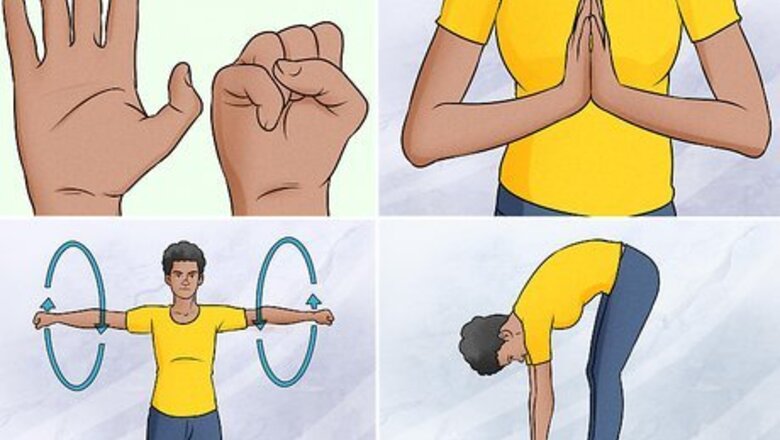
views
Reducing Strain on Your Arms
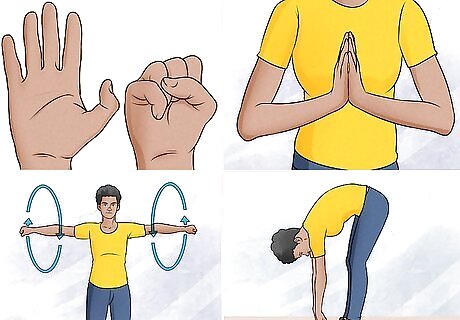
Stretch before driving and during breaks. Stretching your muscles before driving will improve circulation and flexibility. You should stretch your back as well as your arms, since back strain and misalignment can cause arm pain. Stretch your hands by extending your fingers and holding them outstretched for 10 seconds. Relax them, then bend your fingers at the knuckles, hold for 10 seconds, and repeat the sequence. Hold your hands palm to palm in front of you in a praying pose. Keeping your palms together and elbows up, more your hands downward and hold for 10 seconds. Return to the praying position and, with your palms still together, point your fingers to the left and right. Inhale and extend your arms up and around you as far as possible to trace an imaginary circle around yourself. Exhale and trace the imaginary circle downward to bring your arms back to your sides. While standing, bend over to reach for your toes to stretch your lower back. Count to 10 as you hold the stretch. Bend your knees slightly if necessary.
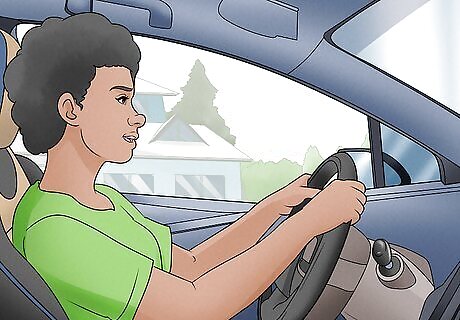
Grip the steering wheel loosely and with your arms relaxed. Use a loose grip on the steering wheel, and change your grip frequently. Move your fingers around to keep your hands and wrists from cramping. Your arms should be relaxed with your shoulders and upper arms by your sides and your elbows slightly bent. Avoid locking your elbows or gripping the steering wheel with tense, fully extended arms.
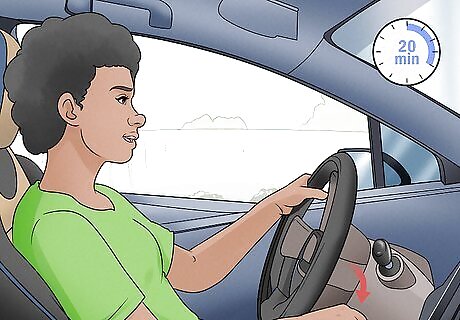
Relax an arm every 15 to 20 minutes during long drives. It's safest to keep both hands on the steering wheel at all times. However, if you're on a long drive and can safely do so, take 30 seconds to relax one arm. Hold it by your side completely relaxed, then rest the other arm for 30 seconds at the next safe opportunity. A low-traffic area with minimal turns would be a good opportunity to rest an arm for at least 30 seconds. If your route has a lot of traffic and turns, you should keep both hands on the wheel.
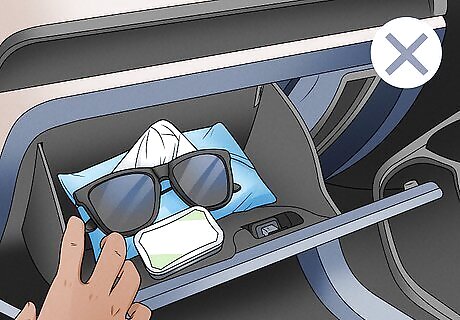
Avoid reaching awkwardly for things. Place mints, tissues, sunglasses, or any other items you anticipate needing within a foot of the driver's seat. Avoid reaching uncomfortably for the glove compartment or toward the passenger and back seats. Keeping items within easy reach will help prevent awkward reaching that can result in arm pain. Pull over if you need something that's not easily accessible.
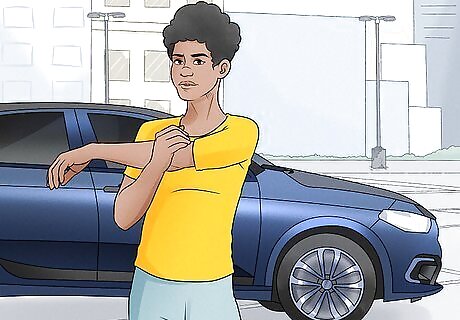
Take a break every hour. If you're on a long drive, avoid forcing yourself to make the trip without taking breaks every hour or so. Give yourself at least an extra half hour so you'll have time to stop and get out of the car. During your breaks, stretch your arms, hands, and back, and walk around for a few minutes.
Making Your Car Ergonomic
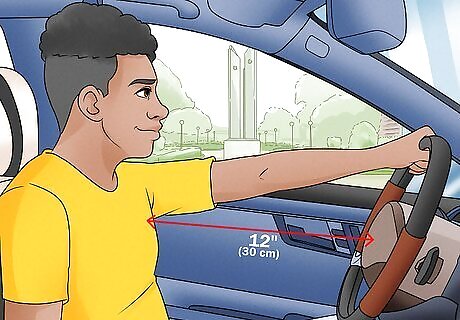
Adjust the seat and steering wheel. Position the steering wheel 10 to 12 inches (25 to 30 cm) from your breastbone. Adjust your seat so your back comes in complete contact with the seat and headrest. Your seat should be reclined about 100 to 110 degrees. Adjust your seat making sure that your seat is properly aligned and at a distance from the steering wheel where your elbows are bent between 90-120 degrees. Consult your vehicle's manual for help adjusting your seat and steering wheel.

Use a seat belt shoulder strap cushion. Seatbelts can irritate or constrict your shoulder, causing discomfort. Look for a shoulder cushion online or at your auto store. You can also cut a piece of soft pipe or foam insulation to appropriate size and attach it to the seat belt.
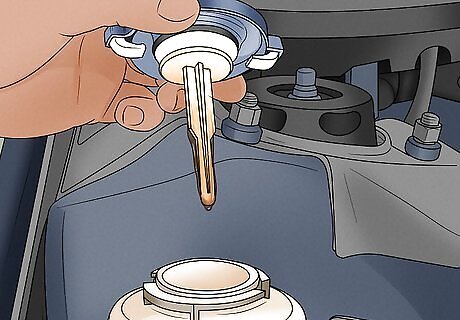
Check the power steering fluid. Low power steering fluid can make it more difficult to steer your car, which can aggravate hand, wrist, and arm pain. Check, add, or flush your power steering fluid, or bring your car to a mechanic for maintenance. If you suffer significant arm pain and your car doesn't have power steering, consider getting one that does. EXPERT TIP Hovig Manouchekian Hovig Manouchekian Auto Repair & Design Specialist Hovig Manouchekian is an Auto Repair and Design Specialist and the Manager of Funk Brothers Auto, a family-owned business operated since 1925. With over 30 years of experience in the automotive industry, Hovig specializes in the process of auto repair and maintenance. He is also very knowledgeable in common automotive issues and needs including engine repair, battery replacement, and windshield accessory and maintenance. Hovig's knowledge and hard work have contributed to Funk Brothers Auto winning Angie's List Super Service Award for five consecutive years. Hovig Manouchekian Hovig Manouchekian Auto Repair & Design Specialist Top up your power steering fluid to ensure a smooth ride. Contaminated power steering fluid is a common cause of a stiff steering wheel, as are low levels of fluid. Fix contaminated fluid with a system flush. If the fluid level is low, there may be a leak in the system. Keep the reservoir filled with fresh fluid.
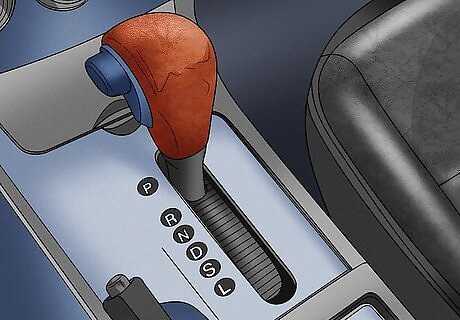
Use a car with an automatic transmission. An automatic transmission reduces the type and number of motions necessary to drive a car. Reducing the frequency and variety of grips and movements will help prevent your arms from getting sore. If you drive a car with a manual transmission, consider getting an automatic.
Consulting Professionals
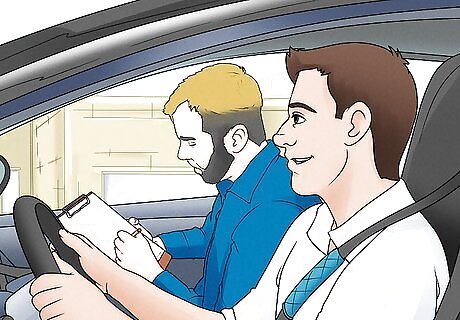
Consult a driving rehabilitation specialist. A driving rehabilitation specialist can observe you driving and help you find ways to develop more ergonomic habits. If your profession involves driving, talk to your employer or union representative. Contact your local jurisdiction's department of driver services for more information about driver rehabilitation. You can also find resources on the Association for Driver Rehabilitation Specialists website.

Make an appointment with your primary doctor. Ask your primary care doctor to examine the affected area. They can offer pain management tips, a prescription medication, or refer you to a specialist. Check with your insurer to make sure any medication or specialist care is covered and in-network to avoid unexpected medical bills.
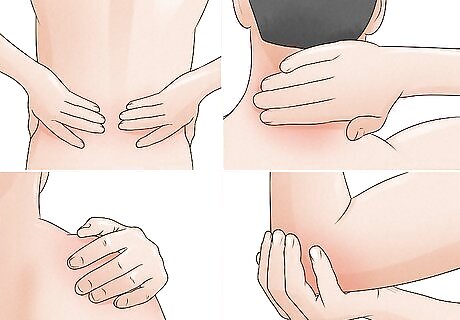
Ask about musculoskeletal disorders. Ask your doctor or specialist if your arm pain indicates any potential muscle, bone, or joint issues. Frequent driving or improper driving habits can result in issues like carpal tunnel syndrome, rotator cuff injuries, repetitive strain injury, or bursitis. Driving can also cause and aggravate arthritis, especially in older adults. Describe the motions that cause pain, the affected areas, and whether the pain is dull or sharp. Ask your doctor or specialist, “Are my symptoms signs of any chronic disorders? Will medication or physical therapy be effective treatment options?”
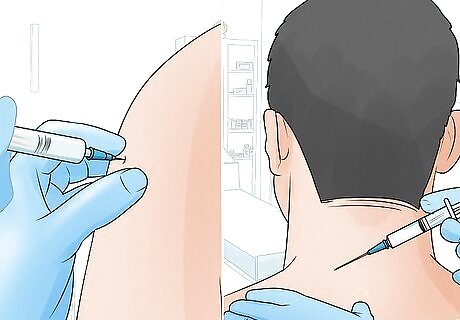
Discuss your treatment options. If your pain continues despite adopting ergonomic driving habits, your doctor can recommend a variety of treatments. Common options include anti-inflammatory or anti-pain medication and physical therapy. Depending on the severity of your case, your doctor may also recommend other treatments, such as cortisone injections, steroid injections, or surgery.




















Comments
0 comment